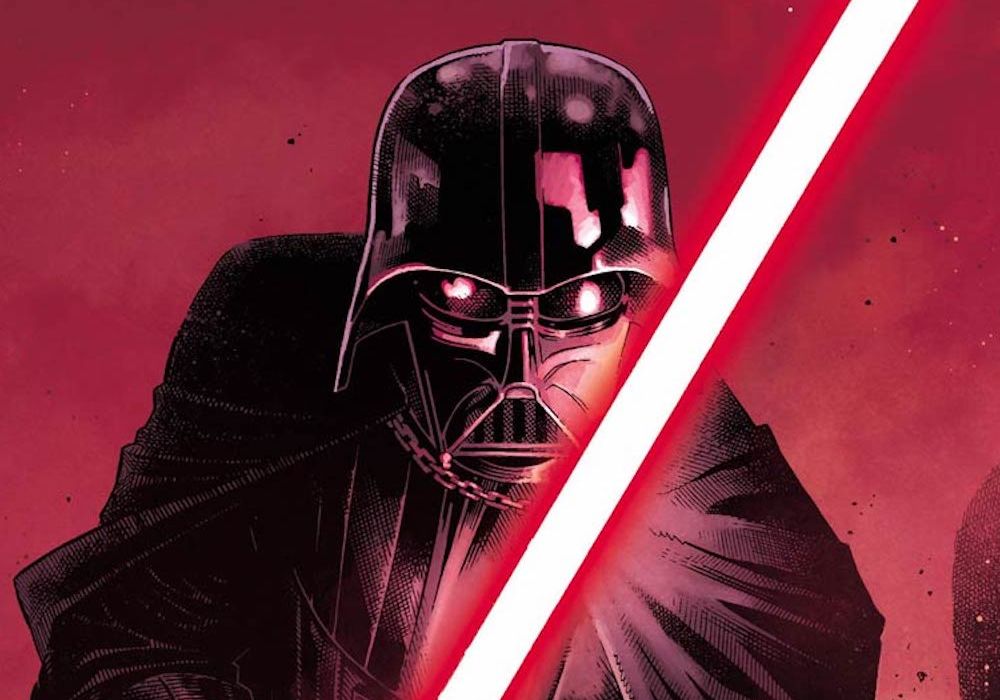“Darth Vader” #1 presents a new take on an old era, expanding upon known elements in a new way.
Written by Charles Soule and Chris Eliopoulos”Cover
Illustrated by Giuseppe Camuncoli and Chris Eliopoulos
Colored by David Curiel and Jordie Bellaire
Lettered by VC’s Joe CaramagnaThe most fearsome villain of all time returns with an all-new series! When Anakin Skywalker fell, both to the pull of the dark side and to the blade of Obi-Wan Kenobi, he rose back up, more machine than man. Having lost everything that was once dear to him, the former chosen one must take his first steps into a darker world…as Darth Vader, Dark Lord of the Sith!
One of the first things that readers of the prior volume of the comic titled “Darth Vader” may notice is just how differently Charles Soule and Giuseppe Camuncoli portray the eponymous fallen hero, when compared to Kieron Gillen and Salvador Larroca’s prior work. Whereas the 2015-2016 series focused on the Sith Lord’s attempts to regain his menace through political intrigue as much as brute force between the fourth and fifth episodes in the Star Wars film franchise, Soule and Camuncoli instead show an inexperienced neophyte in the ways of the Sith who is nonetheless a trained Force user and former Jedi. As such, Soule and Camuncoli are capable of showing a raw and less informed Anakin Skywalker who is more physically and psychologically vulnerable, enabling the writer to explain newer elements in the Star Wars canon that had not come up on film nor television.
Central to Soule’s take is a sense of intense dramatic irony. While the newly crowned Emperor Palpatine says he is a friend to his latest apprentice, readers would know the truth: his complete disregard for anyone who is not himself. While Vader seems taken with his “friend,” this approach allows the audience a feeling of both sadness and creeping dread as the poisonous nature of Palpatine’s false amicability is made blatantly apparent, albeit ignored by the thoroughly broken protagonist of the story. The story is not a question of whether or not Vader will fall from grace, nor how far down he will go. Rather, readers are left to wonder how he will get there, and what steps will be taken to attempt to stifle what little humanity he has left.
Furthermore, Soule uses this issue to begin delving into just how different the Sith are from the Jedi. The Sith are a parasitic culture when combined with Dark Side teachings. In this, Vader acts a surrogate for the uninformed reader, whereas Palpatine instead takes the role of an audience member who is more aware of the recent lore, such as the methods by which the trademark red lightsabers of the Sith are obtained and created.
Giuseppe Camuncoli’s artistry shows a variety of distinct settings, each of which has an effect on reader perception. The dark sterility of the planetwide metropolis of Coruscant emphasizes how well Vader fits in with this new anti-Jedi culture. On the other hand, the unnamed desert planet gives a look at how scary a Sith, untrained or not, can be to common scavengers, as the brighter color palette used by David Curiel casts further emphasis on Vader’s black armor.
Perspective is key to Camuncoli’s art style. The foreboding angles at which Palpatine is shown focus in on his menace and corruptive presence. These images range from the bottom-up view of him hurling Force lightning to the half-shadowed visage when leaving Vader to his first mission in his new armored suit.
Similar to how Palpatine is presented to Vader, the eponymous Sith apprentice himself is given a terrifying presence to contrast with the common smugglers on the aforementioned desert planet. Viewing the world through the eyepieces of his infamous helm, the reader gains some of his perspective in a similar way to a monster’s point-of-view in a horror movie. He is given bottom-up perspectives like his master, whereas the scavengers are shown with top-down ones to illustrate their powerlessness.
The highly detailed faces of Camuncoli’s characters also provide a great deal of depth to the reader reactions. Palpatine’s Dark Side disfigurement is shown with its many wrinkles, the shadow of his hood only emphasizing his sinister visage, especially when the dialogue means to make a point of how evil he truly is. By contrast, Vader’s unseen face goes to show how guarded his own emotions are for the most part when he is not shown as borderline emotionally dead, with further emphasis on his actions and words over any facial dialogue. The emphasis on faces is such that at times when Palpatine’s own is less visible, it gives readers a kind of false comfort, allowing them into Vader’s shoes as the emperor’s “friend” before pulling the rug back out from under them.
Continued belowThe seriousness is such that the short story at the end of the issue, ‘No Good Deed…’ is enough to make some readers laugh despite its simplicity. Chris Eliopoulos and Jordie Bellaire craft a cartoonish art style with thicker lines and exaggerated faces, giving even the gruesome deaths in the tale a sense of black comedy.
Mixing dread, despair, and a bit of an infodump, “Darth Vader” #1 provides an interesting look into the beginnings of the toxic friendship between the eponymous character and his Sith master, teaching readers while also assuming that they have some knowledge of the Star Wars franchise.
Final Verdict: 8.0 – With a feeling of looming dread, Charles Soule and Giuseppe Camuncoli provide an interesting view into the life of a newly corrupted Sith apprentice, giving a look at Darth Vader that the audience seldom is afforded.




